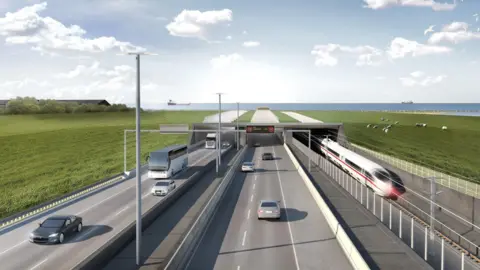The ambitious project of constructing a record-breaking tunnel beneath the Baltic Sea is set to redefine connectivity between Denmark and Germany. This massive infrastructure endeavor involves an 18-kilometer (11-mile) tunnel known as the Fehmarnbelt, which, upon completion, will stand as the longest pre-fabricated road and rail tunnel in the world.
The construction of the Fehmarnbelt aligns with the vision of enhancing Scandinavian links to central Europe, thereby facilitating faster travel across the region. The remarkable engineering behind this project features a novel approach, in which the tunnel segments will be placed directly onto the seafloor before being joined together, marking a significant departure from traditional methods employed in underwater tunneling.
The project’s primary construction site is situated on the coast of Lolland Island in southeastern Denmark, a strategic location that supports the extensive logistical needs of the tunnel’s assembly. The site spans over 500 hectares (1,235 acres) and includes a port and manufacturing facility dedicated to producing the tunnel sections, technically referred to as “elements.” Henrik Vincentsen, the chief executive of Femern, the Danish state-owned company overseeing the tunnel’s construction, describes the facility as “a huge operation” that is crucial for the project’s success.
To create each element, which measures 217 meters (712 feet) in length and 42 meters in width, a combination of reinforced steel and concrete is utilized. Unlike other underwater tunnels, such as the 50-kilometer Channel Tunnel linking the UK and France, where the construction burrows through bedrock, the Fehmarnbelt will consist of 90 segments linked together like Lego bricks. This innovative approach promises efficiency and a record-setting construction timeline, as the immersed tunnel concept has never been executed on such a grand scale.
Financially, the project comes with an estimated cost of €7.4 billion ($8.1 billion; £6.3 billion), largely financed by Denmark, alongside a contribution of €1.3 billion from the European Commission. This venture represents one of the largest infrastructural projects in the region, falling within broader EU initiatives aimed at strengthening travel links across Europe while promoting sustainable transportation alternatives.
Upon completion of the tunnel, the travel time between Rødbyhavn in Denmark and Puttgarten in Germany will be reduced dramatically, with car journeys taking just 10 minutes and train trips clocking in at seven minutes. This replaces the need for a 45-minute ferry ride, thus streamlining transportation and creating a greener pathway for both freight and passenger transport.
The economic implications of the tunnel extend beyond immediate travel benefits; they promise to spark job growth, enhance business opportunities, and attract tourism to Lolland, one of Denmark’s less affluent regions. Mr. Vincentsen asserts that the tunnel’s completion is a win-win scenario, stating, “Everybody’s a winner,” as it symbolizes a crucial link between Scandinavia and central Europe while concurrently reducing carbon emissions through shorter trips.
Despite facing opposition from ferry operators and environmentalists, who were concerned about the ecological repercussions, the project has moved forward following a court ruling in favor of its continuation in 2020. Environmental organizations, such as Nabu, emphasized the need to safeguard the Baltic’s sensitive ecosystems during construction, prompting developers to establish initiatives aimed at minimizing ecological disruption.
When the tunnel opens in 2029, an estimated 100 trains and 12,000 vehicles are projected to traverse it daily. Revenue generated from toll fees will support the loan repayments initiated to fund its construction. According to estimates, it will take approximately 40 years for these loans to be repaid, with the users ultimately covering the costs.
In essence, the Fehmarnbelt tunnel construction project is more than just a civil engineering achievement; it is a transformative endeavor that stands to reshape travel, commerce, and regional relations in Northern Europe, promising a more interconnected future for Denmark, Germany, and beyond.



